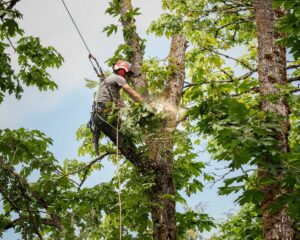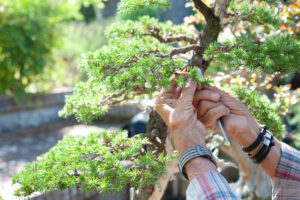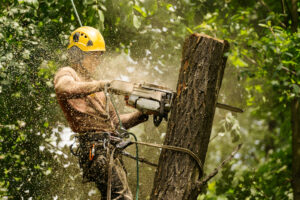The Importance of Regular Tree Trimming and Pruning
Trees are more than just a decorative element in our landscapes; they are essential for the environment and our well-being. Regular tree trimming and pruning are critical practices for maintaining the health, safety, and aesthetics of trees. These practices involve the careful removal of specific parts of a tree, such as branches or roots, to improve the tree’s structure, health, and appearance. Understanding the importance of regular tree trimming and pruning can help homeowners and property managers make informed decisions about their landscape maintenance.
Enhancing Tree Health
Regular trimming and pruning significantly enhance tree health. Removing dead, diseased, or damaged branches prevents the spread of decay and disease. When these unhealthy branches are cut away, the tree can redirect nutrients and energy to healthier parts. This redirection promotes robust growth and improves the tree’s overall vitality.
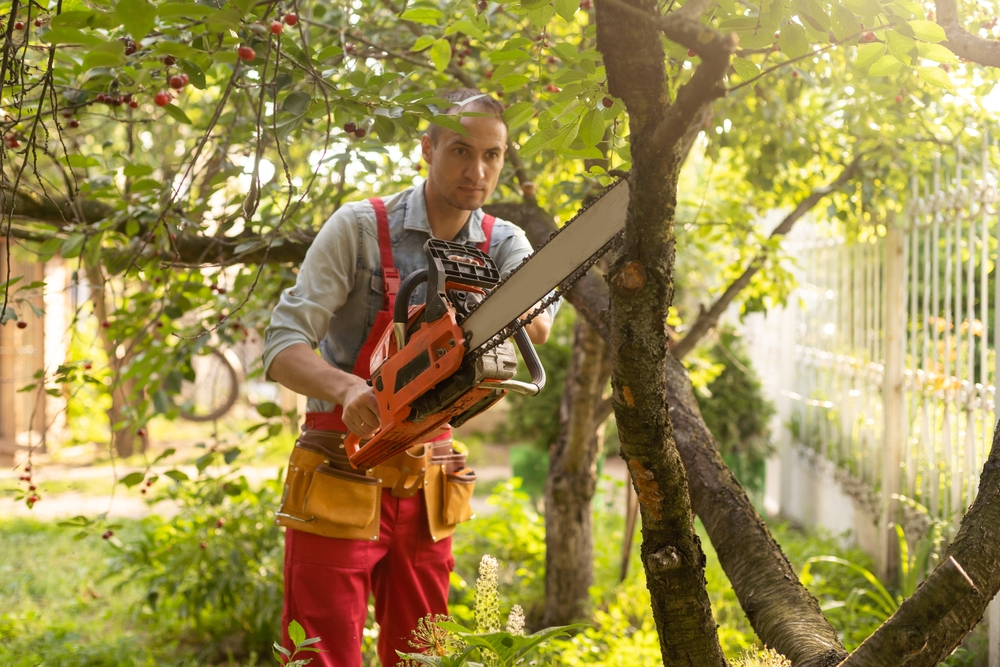
Moreover, trimming and pruning can prevent the development of weak branches that may snap during storms. These weak branches can become entry points for pests and diseases. By removing them, we reduce the risk of infestations and infections. Additionally, pruning helps to open up the canopy, allowing better air circulation and sunlight penetration. These factors are vital for photosynthesis and overall tree health.
Promoting Safety
Tree trimming and pruning are essential for safety reasons. Overgrown branches can pose significant hazards to people and property. For instance, branches hanging over roofs, power lines, or walkways can cause accidents or damage if they fall. Regular pruning helps mitigate these risks by keeping branches at a safe distance from structures and pathways.
Furthermore, trimming can prevent branches from obstructing views or traffic signs, enhancing road safety. It can also reduce the weight of the tree, minimizing the risk of branches breaking during heavy winds or storms. By addressing these safety concerns proactively, we can prevent accidents and injuries.
Improving Aesthetics
Well-maintained trees add beauty and value to any property. Regular trimming and pruning help shape the tree, giving it a balanced and attractive appearance. By removing overgrown or irregular branches, we can create a pleasing silhouette that complements the landscape.
In addition, pruning can enhance the tree’s natural form and highlight its best features. This process can make the tree a focal point in the garden, increasing the property’s curb appeal. Moreover, a well-pruned tree can blend harmoniously with other plants and landscape elements, creating a cohesive and visually appealing environment.
Encouraging Fruit Production
For fruit-bearing trees, regular pruning is essential to encourage healthy fruit production. By removing dead or overcrowded branches, we can stimulate the growth of new, productive shoots. This process allows more sunlight to reach the inner branches, promoting the development of high-quality fruit.
Additionally, pruning can help manage the size and shape of the tree, making it easier to harvest the fruit. It can also prevent the tree from becoming too dense, which can reduce air circulation and increase the risk of disease. By maintaining a well-pruned fruit tree, we can enjoy bountiful and healthy harvests year after year.
Preventing Property Damage
Trees with overgrown branches can cause significant property damage. Branches that are too close to buildings can scratch roofs, walls, and windows. During storms, these branches can break off and cause severe damage to structures. Regular trimming helps prevent these issues by keeping branches at a safe distance from buildings.
Moreover, trimming can protect utility lines and infrastructure. Overgrown branches can interfere with power lines, causing outages and posing fire hazards. By keeping branches away from these critical infrastructures, we can ensure their safe and uninterrupted operation.
Enhancing Tree Longevity
Regular trimming and pruning can significantly enhance the longevity of trees. By removing dead or diseased branches, we prevent the spread of decay, which can weaken the tree over time. Pruning also helps to manage the tree’s structure, reducing the risk of branch breakage and other damage.
Additionally, trimming can improve the tree’s overall resilience to environmental stresses. By promoting healthy growth and reducing the risk of disease, we can help trees withstand adverse conditions such as drought, storms, and pests. This proactive care can extend the lifespan of trees, allowing them to thrive for many years.
Encouraging New Growth
Pruning is a powerful tool for encouraging new growth in trees. By cutting back specific branches, we stimulate the tree to produce new shoots and leaves. This process can rejuvenate older trees, giving them a fresh and vibrant appearance.
Furthermore, pruning can help manage the tree’s growth pattern. By removing unwanted branches, we can direct the tree’s energy towards more desirable growth. This control can help maintain the tree’s shape and size, ensuring it fits well within the landscape.
Reducing Pest Infestations
Regular trimming and pruning can reduce the risk of pest infestations. Dead and decaying branches can attract various pests, including insects and rodents. These pests can cause significant damage to the tree and even spread to other plants in the landscape.
By removing these branches, we eliminate potential habitats for pests. Pruning also helps improve air circulation and sunlight penetration, which can deter pests from settling in the tree. By maintaining a healthy and well-pruned tree, we can create a less hospitable environment for pests.
Improving Air Circulation and Sunlight Exposure
Proper air circulation and sunlight exposure are crucial for tree health. Overgrown branches can create dense canopies that limit airflow and block sunlight. This limitation can hinder photosynthesis and increase the risk of disease.
Regular pruning helps to open up the canopy, allowing more air and light to reach the inner branches. This improvement can enhance photosynthesis, promoting healthy growth and development. It can also reduce the risk of fungal diseases, which thrive in dark and damp conditions.
Supporting Structural Integrity
Tree trimming and pruning are vital for maintaining the structural integrity of trees. By removing weak or poorly attached branches, we can prevent them from breaking and causing damage. Pruning also helps to distribute the tree’s weight more evenly, reducing the risk of structural failure.
Moreover, trimming can help manage the tree’s growth habit. By guiding the tree’s development, we can ensure it grows in a strong and balanced manner. This management can prevent issues such as leaning or overcrowding, which can compromise the tree’s stability.
Promoting a Healthy Root System
A healthy root system is essential for the overall well-being of trees. Overgrown branches can put excessive strain on the roots, leading to imbalances and stress. Regular trimming helps to manage the tree’s growth, reducing the burden on the root system.
Furthermore, pruning can improve the tree’s access to nutrients and water. By reducing the tree’s overall size, we can help ensure the roots have enough resources to support healthy growth. This balance can promote a strong and resilient root system, which is critical for the tree’s stability and longevity.
Enhancing Flowering
For flowering trees, regular pruning can enhance bloom production. By removing dead or overcrowded branches, we can stimulate the growth of new flower buds. This process can lead to more abundant and vibrant blooms, adding beauty to the landscape.
Additionally, pruning can help manage the tree’s size and shape, ensuring it remains aesthetically pleasing. By maintaining a well-pruned flowering tree, we can enjoy its beauty and fragrance for many years.
Preventing Storm Damage
Storms can cause significant damage to trees, especially those with overgrown or weak branches. Regular trimming helps to strengthen the tree by removing vulnerable branches that are likely to break during storms. This preventive measure can reduce the risk of storm damage and improve the tree’s overall resilience.
Moreover, pruning can help manage the tree’s canopy, reducing wind resistance and the likelihood of toppling. By maintaining a well-pruned tree, we can protect it from the adverse effects of severe weather conditions.
Supporting Environmental Benefits
Trees provide numerous environmental benefits, including improving air quality, reducing soil erosion, and supporting wildlife. Regular trimming and pruning help to maintain healthy and robust trees, enhancing these environmental benefits. Healthy trees can absorb more carbon dioxide, produce more oxygen, and provide better habitats for wildlife.
Additionally, well-maintained trees contribute to the aesthetic and ecological value of the landscape. By ensuring trees remain healthy and vibrant, we can support a sustainable and thriving environment.
Professional Tree Care
While some tree trimming and pruning tasks can be done by homeowners, others require professional expertise for tree trimming and pruning. Certified arborists have the knowledge and skills to perform these tasks safely and effectively. They can assess the tree’s health and structure, identify issues, and recommend appropriate pruning techniques.
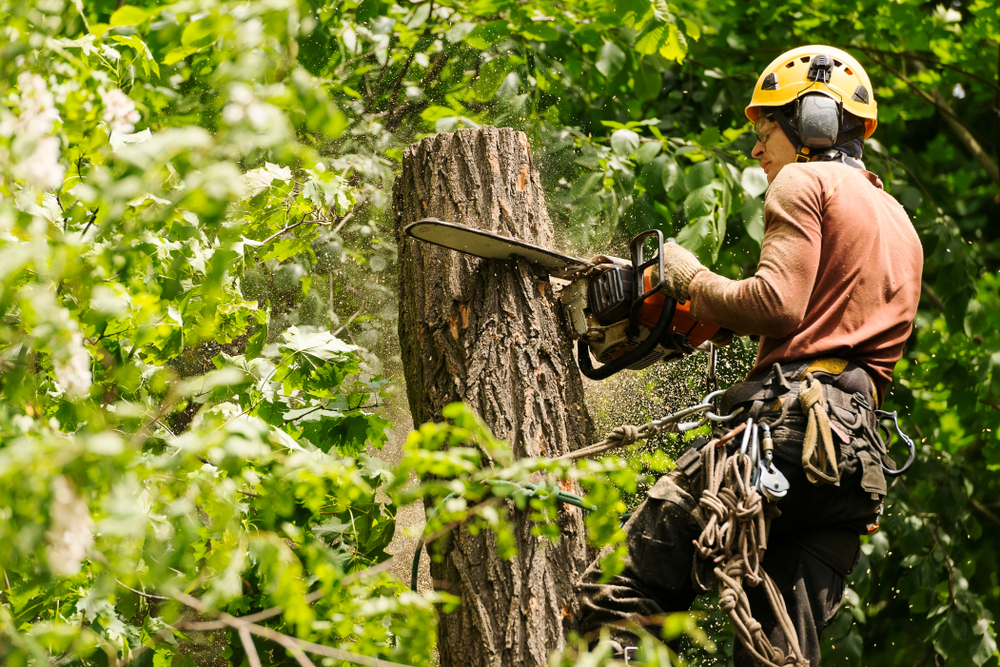
Moreover, professional tree trimming services have the necessary equipment to handle large or hazardous trees. They can ensure the job is done correctly, reducing the risk of injury or damage. By investing in professional tree care, homeowners can ensure their trees receive the best possible care.
Seasonal Considerations
The timing of tree trimming and pruning is crucial for achieving the best results. Different trees have different pruning needs based on their growth cycles. For instance, deciduous trees are best pruned during their dormant season, usually in late winter or early spring. This timing allows for better wound closure and reduced risk of disease.
On the other hand, evergreen trees can be pruned throughout the year, although late winter to early spring is generally preferred. Fruit trees often require pruning during late winter to promote new growth and fruit production in the coming season. Understanding the seasonal needs of different trees can help ensure effective and beneficial pruning.
Conclusion
Regular tree trimming and pruning are essential practices for maintaining the health, safety, and aesthetics of trees. These practices not only enhance tree health and longevity but also promote safety and improve the appearance of the landscape. By encouraging fruit production, reducing pest infestations, and preventing storm damage, regular pruning offers numerous benefits. Additionally, professional tree care services can provide the expertise and equipment needed for effective pruning. By understanding the importance of these practices and implementing them appropriately, homeowners and property managers can ensure their trees thrive for many years, contributing to a beautiful and sustainable environment.
Tree Trimming Richmond
(804) 533-3943
https://treetrimmingrichmond.com/

